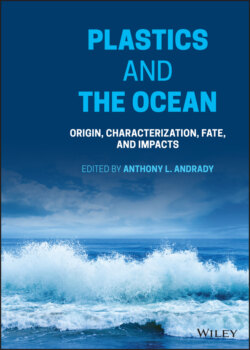Читать книгу Plastics and the Ocean - Группа авторов - Страница 20
1.3 Ingestion of Microplastics Marine Organisms
ОглавлениеThat the marine environment contains numerous natural particles in the same size range as MPs/NPs that in any event constitute only a small fraction of all particles, is often pointed out. Marine organisms having evolved in this particle‐rich environment are reasonably expected to be not particularly affected by them. However, it is the high level of both sorbed or adsorbed chemicals in MPs that set them apart from the many inorganic “fines” abundantly found in seawater that may carry only surface‐adsorbed pollutants. The MPs and NPs with sorbed POPs are well known to be ingested by organisms ranging from zooplankton (Cole et al. 2013; Sun et al. 2017) to whales (Fossi et al. 2014; see Chapter 12), providing a pathway for these chemicals into biota (Hartmann et al. 2017). Particular attention has been paid to marine birds (Fry et al. 1987), where over 25% of the species (Pham et al. 2017), and sea turtles, where all species, are reported to ingest plastics (Kühn and van Franeker 2020). A particular concern is the ingestion of MPs and NPs by commercially important fish and seafood species (see Chapter 13). How the entanglement and ingestion risk of MPs relate to their particle size is illustrated in figure 1.7.)
Figure 1.7 Left: Categories of marine plastic debris developed by GESAMP (2015) indicating the size ranges for potential ingestion, and the techniques for their analysis. Right: A schematic showing the origin of plastic micro‐debris.
Source: Adapted from the same report. SEM ‐ Sacnning Electron Microscopy; TEM ‐ Transmission Electron Microscopy; AFM ‐ Atomic Force Microscopy; and AFM‐IR ‐ AFM with infra‐red Spectroscopy.
But, presently, there is no consensus on whether the POPs in ingested MPs do adversely affect the organism. Such effects would be compound‐ and species‐specific, but only a limited combination of POPs/species have been investigated as yet. Relevant data are therefore, quite variable even on species ingesting virgin plastics. For instance, adverse outcomes of ingesting virgin “clean” MPs have been reported for fish species (Jovanović et al. 2018) but were ruled out with sea urchins (Kaposi et al. 2014). An important focus of ingestion studies should also be to asses if the relevant POPs are bioavailable (Avio et al. 2015) to ingesting organisms at a high enough dosage to result in any physiological impacts. Bioavailability (Avio et al. 2015) of POPs is determined by (i) the residence time of MPs in the gut environment, (ii) hydrophobic gut contents that encourage release, and (iii) if POPs molecules can permeate the gut wall to enter systemic circulation (as opposed to being egested). However, data supporting the bioavailability of POPs are available only for several marine species (Bakir et al. 2016; Chua et al. 2014; Schrank et al. 2019), including mussels (Browne et al. 2008) and zebrafish embryos (Batel et al. 2018; Pitt et al. 2018). Bioaccumulation and biomagnification are introduced in Box 1.2.
